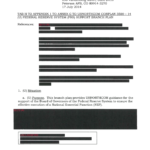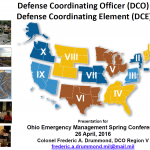
This branch plan provides USNORTHCOM guidance for the support of the Board of Governors of the federal Reserve System to ensure the effective execution of a National Essential Function (NEF).

On order and in response to natural/manmade incidents, the Defense Coordinating Officer / Defense Coordinating Element (DCO/DCE) anticipates and conducts Defense Support of Civil Authorities (DSCA) operations coordinating Title 10 forces and resources in support of the Federal Primary Agency (PA) in order to minimize impacts to the American people, infrastructure and environment.
This bilateral plan provides a framework for military forces of one nation to support military forces of the other nation that are providing military support of civil authorities. The focus of this document is the unique, bilateral military planning considerations required to align our respective national military plans to respond quickly to national requests for military support of civil authorities. Nothing in this plan prevents either nation from responding unilaterally; rather, this plan will facilitate unity of effort, if and when requests for bilateral support are received.
Natural or man-made disasters and special events can be so demanding that local, tribal) state and non-military federal responders are temporarily overwhelmed by the situation. The Department of Defense (DOD) has a long history of supporting civil authorities in the wake of catastrophic events. When directed by the President or the Secretary of Defense (SecDef), United States Northern Command (USNORTHCOM) will respond quickly and effectively to the requests of civil authorities to save livesj prevent human suffering, and mitigate great property damage. The Joint Strategic Capabilities Plan 2008 (JSCP) directs CDRUSNORTHCOM to prepare a plan to support the employment of Title 10 DOD forces providing Defense Support of Civil Authorities (DSCA) in accordance with (IAW) the National Response Framework (NRF), applicable federal law, DOD Directives (DODD), and other policy guidance including those hazards defined by the National Planning Scenarios that are not addressed by other JSCP tasked plans. DSCA is a subset of DOD civil support that is performed within the parameters of the NRF.
The Council of Governors and the President of the United States have identified the need for Dual Status Commanders (DSC) to unify the response efforts within the 54 Territories and States of the United States of America. United States Northern Command (USNORTHCOM) has identified Title 10 Deputy Commanders (O-6 in grade) to lead a Joint Support Force Staff Element (JSF-SE) that will integrate with the State-Level DSC staff in order to provide unity of effort to the response of both Title 32/State Active Duty (SAD) and Title 10 forces. This Standard Operating Procedures document outlines the USNORTHCOM Staff support to the DSC Program, a template for a T10 Deputy Commander Handbook and the methods, procedures and best practices for the JSF-SE.
The North American Aerospace Defense Command (NORAD) and U.S. Northern Command (USNORTHCOM) Publication Series is the authoritative reference defining the Commands’ missions and structure, force employment objectives, mission area planning considerations and operational processes from the strategic to the tactical level. The NORAD and USNORTHCOM Publication Series also defines the Commands’ doctrine, as well as their operational tactics, techniques, and procedures (TTP). The NORAD and USNORTHCOM Publication Series is authoritative because it defines the actions and methods implementing joint doctrine and describes how assigned and attached military forces will be employed in the Commands’ joint and combined operations.
This Study Plan outlines the background, scope, strategic assumptions, study objectives, analysis methodology, scenario considerations, timeline, and management responsibilities in conducting the Homeland Defense and Civil Support Capabilities-based Assessment (HD/CS CBA) to include production of the Functional Area Analysis (FAA), Functional Needs Analysis (FNA) and a Joint Capabilities Document (JCD). This CBA, through the execution of the FAA, FNA. And JCD; identifies, describes, documents, and prioritizes DOD’s capability gaps and excesses in the HD/CS mission areas (to include the Mission Assurance (MA) function).
THIS IS ADVANCE WARNING OF AN ANTICIPATED DECISION BY USNORTHCOM PENDING SECDEF APPROVAL TO INCREASE FPCON IN PREPARATION FOR ACTIVITIES COMMEMORATING THE TENTH ANNIVERSARY OF THE 9/11 TERRORIST ATTACKS. WE ANTICIPATE THAT CDRUSNORTHCOM WILL DIRECT CHANGES TO THE FORCE PROTECTION CONDITION (FPCON) LEVELS ACROSS THE USNORTHCOM AREA OF RESPONSIBILITY (AOR). ALL DOD ELEMENTS TACON FOR FP TO USNORTHCOM WILL PLAN FOR EXECUTION OF FPCON LEVEL BRAVO AND IMPLEMENT SUPPLEMENTAL FP ACTIONS, AS DIRECTED HEREIN, NOT LATER THAN 070600Z SEPTEMBER 2011.
These template of the Standing Rules for the Use of Force developed by Army North (ARNORTH) and approved by Army Judge Advocate General (JAG) School for commands to follow. The first two templates apply to forces under federal control. The third template is an example State RUF card for National Guard personnel in a SAD or Title 32 status. These templates are taken from the “DoD Defense Support to Civil Authorities Handbook” which includes other information relating to military support operations related to civil disturbances.
This Joint Special Event Threat Assessment (JSETA) addresses potential threats to the National Football League (NFL)USPER Super Bowl XLV, which will be played on 6 February 2011 at Cowboys Stadium in Arlington, Texas. It focuses on potential threats to the game—and to various NFL-sanctioned events scheduled for the Dallas/Ft. Worth Metroplex-area during the 12 days prior to the game—from international and domestic terrorists, cyber actors, criminals, and foreign intelligence services.
(U//FOUO) U.S. Northern Command (NORTHCOM) and CONPLAN 3500 CBRNE Response Overview, March 3, 2009.
USNORTHCOM General Population Evacuation by Air Brief from March 17, 2009.
USNORTHCOM Electric Energy Security in the Domestic Theater brief from December 14, 2009
This smart book was compiled by Joint Task Force North in response to a support request by the United States Border Patrol. The purpose is to provide the Department of Homeland Security with a basic reference and questioning guide to determine the validity of an apprehended individual’s stated country of origin and to assist in identifying those that are Special Interest Aliens (SIAs). Customs and Border Protection identifies thirty-four countries and two territories as special interest countries. This is current as of March 1, 2008.
The purpose of the Canada-United States Civil Assistance Plan (CAP) is to provide a framework for the military of one nation to provide support to the military of the other nation in the performance of civil support operations (e.g., floods, forest fires, hurricanes, earthquakes, and effects of a terrorist attack).
•DoD is not the Lead Federal Agency
•Provide support only as directed
•Potential missions cover an extremely broad range of activities –anywhere in North America
•Communication interoperability still a nebulous concept
•Strategic, Operational or Tactical?
• NORTHCOM: Initial OPCON and FHP guidance/requirements
• JFMCC: OPCON of Naval assets unless given TACON to JTF-Katrina
• JTF-Katrina: Once stood-up, NORTHCOM gave OPCON to assets in JOA; refine FHP guidance/requirements
JTF-CS anticipates, plans and integrates USNORTHCOM Chemical, Biological, Radiological, Nuclear, and high-yield Explosive (CBRNE) Consequence Management operations and when directed, establishes command and control of DoD forces for a CBRNE incident to assist local authorities in saving lives, preventing injury, and providing temporary critical life support.
•Occurs mostly during fall/winter in U.S.
•Spread by air-borne droplets
•Viral shedding begins before symptoms start and may continue after symptoms begin to resolve
•Symptoms –fever, dry cough, aches and pains, malaise, runny nose
•Nausea, vomiting and diarrhea are extremely rare
•Symptoms may last 5-7 days in healthy individuals
• NEP encompasses the following:
• Homeland Security Exercise and Evaluation Program (HSEEP)
• Five-Year National Exercise Schedule
• Corrective Action Program (CAP)
• Lessons Learned Information Sharing (LLIS) System
• President George W. Bush approved the NEP Implementation Plan (I-Plan) on April 11, 2007; the Homeland Security Council (HSC) and the Deputies Committee approved modifications to the NEP IPlan and Five-Year National Exercise Schedule in December 2008
•NORAD-USNORTHCOM Quick Overview
•Military Mortuary Affairs – Roles, Missions, Forces
•How and when to request support
•NORAD – A Bi-National Command (US, Canada)
•Aerospace Warning and Control
NORAD Missions: Aerospace Warning: Detect, validate, characterize, assess and warn of attacks against North America, whether by aircraft, missiles or space vehicles. Aerospace Control: Detect and respond to unauthorized and unwanted air activity approaching or operating within North American airspace.
To present a general overview and understanding of JTF-CS roles, responsibilities and tools ISO CBRNE-CM (Chemical, Biological, Radiological, Nuclear, High Yield Explosive – Consequence Management) Operations. “USNORTHCOM anticipates and conducts Homeland Defense and Civil Support operations within the assigned area of responsibility to defend, protect, and secure the United States and its interests.“ GEN Renuart (14 NOV 07)
USNORTHCOM has been assigned the Force Protection (FP) mission and AT Program responsibility for the USNORTHCOM AOR. The purpose of the FP mission is to defend, detect, and mitigate against terrorist attacks directed at DoD personnel, infrastructure, resources, and information to ensure DoD’s continued warfighting capability. The scope of this mission extends to all DoD Elements and personnel in the USNORTHCOM AOR, whether assigned or unassigned to USNORTHCOM. While the FP mission supports USNORTHCOM’s primary missions of Homeland Defense (HLD) and Civil Support (CS), it is a separate task assigned in the Unified Command Plan (UCP) (ref. a.) and is executed through a different chain of command from the specified USNORTHCOM missions of HLD and CS. The successful execution of the USNORTHCOM FP mission enables the USNORTHCOM HLD and CS missions, and assures availability of DoD assets in support of other Combatant Command-assigned missions.